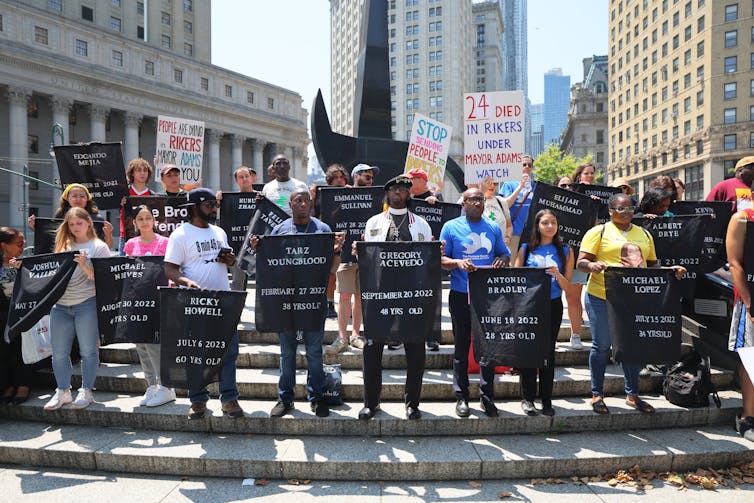
The family of Samuel Lawrence, one of 10 people to die in Georgia’s Fulton County Jail in 2023, is fighting for answers and accountability.
“I got to think about him every day of my life and I don’t know when the pain stops,” Lawrence’s father, Frank Richardson, told a local TV station in October 2023. “I pray to God that he touches that jail and puts people in place to help the other ones that are left behind.”
Shortly before his death, Lawrence, 34, had filed a complaint about jail conditions, alleging that he was brutally beaten and isolated, with insufficient food and water.
But Fulton County Sheriff Patrick Labat largely blamed the jail’s “outbreak of violence” on “the long-standing, dangerous overcrowding and the crumbling walls of the facility.”
In order to “save lives,” Labat said, his county would be requesting a “replacement jail.”
The Georgia sheriff is among many law enforcement officials to claim that people like Samuel Lawrence would be safer if communities reduced overcrowding by building new jails or enhancing existing ones.
But recent research my colleague Weiwei Chen and I published on escalating jail mortality rates nationwide calls into question that rationale.
In an article published in the June 2023 issue of Health Affairs, we examined relationships between jail conditions and jail deaths, analyzing factors such as percent of jail capacity occupied, admission and discharge rates and population demographics.
Among the variables that appeared to be most significantly related to jail mortality were turnover rate – the number of people admitted to and discharged from a facility relative to its average population – as well as the percentage of Black people in the jail population.
Jail mortality
Jails are sometimes referred to as the “front door” of the criminal justice system. Unlike prisons, which are run by federal and state governments and hold convicted people serving relatively long sentences, jails are locally managed, and the majority of their populations are being detained pretrial while unconvicted.
Data on how many people die while incarcerated is notoriously inaccessible and often unreliable. Still, available reports on jail deaths from the Bureau of Justice Statistics offer some perspective.
In 2019, overall jail death rates were below the adjusted national average of 339 per 100,000, but leading up to that year, they had steeply increased. Between 2000 and 2019, jail mortality rose by 11%, from 151 per 100,000 to 167 per 100,000.

To conduct what epidemiologist Homer Venters referred to as an “apples-to-apples comparison” of circumstances and deaths in multiple jails during a period of escalating mortality, we relied on a combination of datasets.
For information about facility deaths, we turned to statistics compiled by Reuters news agency reporters, who submitted Freedom of Information Act requests to obtain mortality data from the largest jails across the U.S.
Our data on jail conditions – such as annual admissions and releases, facility capacities and demographics – came from the Bureau of Justice Statistics’ census and annual survey of jails.
Ultimately, we assessed mortality rates and conditions in approximately 450 U.S. jails between 2008 and 2019.
Some of our most robust findings about jail deaths had to do with two factors: turnover rate – the sum of weekly admissions and releases divided by average daily population – and demographics.
In the jails we examined, average turnover was 67% (slightly above the national average of 53%). Relatively high turnover rates, we found, were associated with higher death rates overall, as well as due to suicide, drugs and alcohol, and homicide.
In addition to revealing a relationship between turnover rate and mortality, our research showed that the presence of greater proportions of non-Hispanic Black people in populations of relatively large jails was associated with more deaths due to illness.
Race-based differences in illness-related deaths could be due to a variety of factors, including populationwide health disparities in the U.S.
Reliance on jails
Our findings about both turnover and racial disparities should be considered alongside the broader context of jail incarceration in the United States.
Roughly 4.9 million people are arrested and jailed each year, some of them multiple times. Overall, there were approximately 10.3 million admissions to more than 3,000 U.S. jails in 2019.
As of 2019, Black people were jailed at a rate more than three times that of white people.
People in jails have been found to be “significantly poorer” than people outside of jails, and more than 30 percent of those who are detained remain incarcerated because they cannot afford to pay bail.
Jailed people are also disproportionately likely to face health challenges. They are more likely to report having had chronic health issues, infectious diseases, mental illnesses and substance use problems.
The United States’ remarkably high population of incarcerated people – and the composition of that population – are related to decades’ worth of cuts in social welfare programs, structural racism, local and national political trends, and policing practices.
Research has shown that the cash bail system – a key driver of high jail turnover – “punishes the poor” by ensuring that they are more likely to be detained than their wealthier counterparts for the same crime. A reliance on cash bail also reportedly increases recidivism and undermines public safety.
Beyond incarceration
Our study suggests that ongoing initiatives geared at reducing incarceration – and by extension, jail turnover – could help achieve Sheriff Labat’s goal of saving lives.

Some communities, for example, have successfully limited the use of cash bail. Others have enhanced community-based services that address mental illness, drug use and homelessness without involving police, so jails are less likely to be sites of first resort for people with complex needs.
A year before Samuel Lawrence died, a report from the ACLU suggested that by adopting at least some of the above measures, Fulton County could “reduce its jail population significantly.”
It could also, our research suggests, save lives.
Funding for this "Scholarly Works" project was made possible by Grant No. G13LM013522-01A1 from the National Library of Medicine, National Institutes of Health. The content is solely the responsibility of the author and does not necessarily represent the official views of the National Institutes of Health.
This article was originally published on The Conversation. Read the original article.







